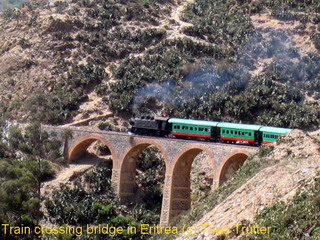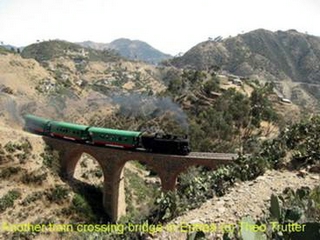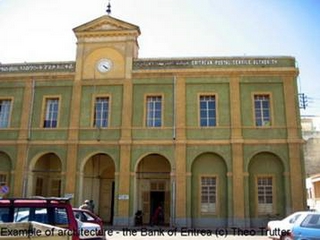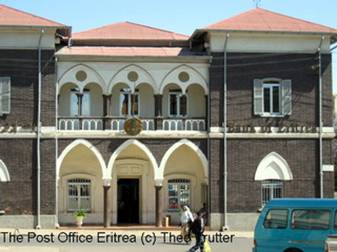When based in Asmara , Eritrea and off-duty , I was determined to research as much of the history of the country. One of the fascinating facets is readily available on the Internet – just search for “steam-trains. ” But finding the restored trains proved more difficult.
I was extremely fortunate to discover the whereabouts of the old Asmara Railway Station being tucked away off the main eastern entrance road that itself meanders up the fearsome passes that connects to the coastal port of Massawa. No locals were able to direct me, especially given the language barrier. I spoke a few words of Tigrinia and most spoke little if any English.
The little station looks exactly like any old movie, as do the little narrow-gauge rolling stock. There are several steam-engines reposing in a shed. They were built in the Italian city of Breda and some date back to 1937. On my first visit there, I learned that a group of German tourists were due to visit there on the next Saturday. I was luckily off-duty that day, so naturally made my way to the station.
 The Germans, an all male group were enthralled and clicked away with every description of cameras and also whirring away with a multitude of video cameras. Fortunately they made no objection to my discreet presence as I too clicked away.
The Germans, an all male group were enthralled and clicked away with every description of cameras and also whirring away with a multitude of video cameras. Fortunately they made no objection to my discreet presence as I too clicked away.
The steam engine puffed up to the carriages with much tooting and then left the station down the mountain passes. At every stone bridge and tunnel, the engine driver obligingly reversed back and forth so that many photos could be taken. At some old halts en route, the tourists were able to disembark in order to take photos at ground level. A fruitful day for them indeed.
Due to the Ethiopian/ Eritrean wars, the railway system got into a serious state of disrepair. Rails and sleepers were used elsewhere for road bridges, buildings or fortifications.
Since the last war ended in 2000, the Eritrean Railway Company got restarted with State assistance. Many aged artisans came out of retirement to show the younger generation exactly how to restore, rebuild and maintain the steam engines and rolling stock.
Many parts of the rail-bed had to be repaired using bulldozers, front-end loaders, graders and labourers, before rejuvenated rails and sleepers could be re-laid.
 The Eritrean railway system had originally been built by the Italians during the ’20’s when they occupied Abyssinia (later renamed Ethiopia) and the meticulous stone bridges and tunnels are a lasting tribute to their artisans. Mines had also to be cleared from many places like bridges, tunnels and roadbeds.
The Eritrean railway system had originally been built by the Italians during the ’20’s when they occupied Abyssinia (later renamed Ethiopia) and the meticulous stone bridges and tunnels are a lasting tribute to their artisans. Mines had also to be cleared from many places like bridges, tunnels and roadbeds.
It was envisaged that steam-train enthusiasts from all over the world would flock to Eritrea to view the unique narrow-gauge system. This of course depends on the fragile peace between Eritrea and Ethiopia, which lately has seen much rhetoric and sabre rattling between the two sides. The UN-presence has been instrumental since 2000 to preserve the peace.
The Practicalities of Getting to Eritrea
Travelling into Eritrea has for years been extremely difficult. They have had many years of wars with their neighbour and former ruler Ethiopia, so thus have become extremely careful of any new arrivals.
As far as is known, genuine tourists that have booked Red Sea dives will obtain visas. In our flying staff’s case, getting a visa was “easy ” provided one followed the UN procedure. This required :
1. Obtaining a fax/e-mail copy of the arriving crew-member’s passport ;
2. Writing a letter to the UN in Asmara [capital of Eritrea] to which one then attached the copy of the incoming crew-member’s passport;
3. I used to visit the Head of the Travel Dept , who in turn dictated another letter addressed to the relevant Colonel of the Eritrean Army;
4. When this letter was typed and signed, one was ready for the next steps;
5. Make 3 photo-copies in advance of everything, as the army & immigration dept photocopy machines were not serviceable.
6. It was found expedient to phone ahead to the Colonel’s office for an appointment but one often found him out, away or busy.
7. When finally seated face-to-face with a very pleasant Colonel, getting the approval letter was usually done quickly, especially as I used to take along a bottle of South African liqueur or a old novel
8. The final step was to the Immigration Department where there invariably a long queue. Of course they too had an application form requiring to be filled in, so I learned to pre-enter it having made photocopies of that as well, beforehand. Visa periods could go to 6 months, but usually they were valid for 30 days.
 If one was lucky enough to get to the counter that day, then the wad of letters and visa application form were handed in and a suitable fee was to be paid in US $ notes-[about $150 was the usual. ] More queues – one at the cashier’s office and another queue back at the Immigration’s Visa counter, to hand over the receipt. It also was not a good idea to have to visit the toilet whilst in the queue.
If one was lucky enough to get to the counter that day, then the wad of letters and visa application form were handed in and a suitable fee was to be paid in US $ notes-[about $150 was the usual. ] More queues – one at the cashier’s office and another queue back at the Immigration’s Visa counter, to hand over the receipt. It also was not a good idea to have to visit the toilet whilst in the queue.
Now came the wait for the Visa to be issued. If the issuing person was in his office, then the Visa would be typed & signed within a few hours, but often it was best to return the next day. More queuing for your turn to find out if the latest wad of visas, brought down from a upstairs office, contained the one you handed in.
On the next day, after patiently waiting in a long queue, one invariably found a semi-literate clerk who could hardly understand English or even Italian, who could not find any of one’s documents. Knowing a few words of the local language, Tigrinya certainly helps. Thus back to one’s own office to start again. The answer was to present him/her with a spare set of photo-copied letters with passport copy and application form, so that they could compare the person’s picture, name and locate the Visa and hand it over.
 Once in possession of the Incoming Crew’s Visa, it was best to scan it, e-mail it to them so as to present it on arrival at Asmara Airport. It was possible for the Immigration department to have the visa on hand on arrival but that took a lengthy wait in yet another queue there.
Once in possession of the Incoming Crew’s Visa, it was best to scan it, e-mail it to them so as to present it on arrival at Asmara Airport. It was possible for the Immigration department to have the visa on hand on arrival but that took a lengthy wait in yet another queue there.
It was not possible to apply for a Visa at the airport of arrival. Anyone arriving without a visa was summarily deported; being put back onto the aircraft that brought you there was the usual procedure. Thus there were of course additional flight and accommodation costs. This happened once to an incoming crew-member required urgently. Nobody realized in time that the Eritrean Army & Immigration Offices would be closed for public holidays on a Tuesday and the next day as well. So although armed with all application forms, UN and Army letters, and presented to Immigration Officials at the Asmara Airport by me beforehand, that incoming crew-member found himself deported! When flying from Nairobi to Eritrea on Eritrean Airlines Boeing 767, they positioned an officious clerk at the aircraft door to expressly check every passenger to make sure they held valid visas.
 Yet another method of visa acquisition was possible; by applying at the Eritrean Embassy. In our case this was in Pretoria but it took a week and cost plenty more than when obtained in Eritrea.
Yet another method of visa acquisition was possible; by applying at the Eritrean Embassy. In our case this was in Pretoria but it took a week and cost plenty more than when obtained in Eritrea.
So good luck!
Theo Truter has been a light aircraft pilot all his life, flying all over Africa for the past 5 years doing UN-Contracts and other Contract flying – and before that a mixture of executive flights, safari flights, air charters, flying training and Consulting. That’s how he came to be in Eritrea, from whence his article’s research was made.
Using his camera he’s indulged in a bit of photo-journalism whenever possible & now has also added to his duties being the Editor for a worldwide weekly newsletter called South Africans Worldwide at www. saw. co. za
